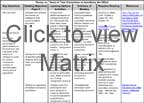Key Questions
- Why do under- achieving gifted students from diverse populations need special considerations for programming and curricular options?
Student performance that falls noticeably short of identified potential, especially in students identified as gifted, is bewildering and potentially the most frustrating of all challenges faced by both teachers and parents. In Week 5 we discussed the gender issues associated with the underachievement of gifted boys and girls. Statistics show that as many as half of our gifted students do not perform up to their assessed abilities in school (National Commission on Excellence in Education, 1983). Studies of high school dropouts estimate that between 18%-25% of the students not graduating are in the gifted range of abilities (Solorzano, 1983; Renzulli & Park, 2000).
Underachievement is defined as a discrepancy between the student’s school performance and some index of his/her actual ability, such as intelligence, achievement, or creativity scores.
Studies of gifted underachievers have identified characteristics that are typical of these students. Joanne Whitmore (1980) summarized some of the most important traits in the following identification checklist.
Whitmore suggests that you observe and interact with the student over a period of at least two weeks to determine if he/she possesses the characteristics listed below. If the student exhibits all of the traits that are asterisked (*) and at least three more traits on the list, then an individual intelligence testing is recommended to establish whether the student is a gifted underachiever.
Identification Checklist
___*poor test performance
___*achieving at or below grade level expectations in one or all of the basic skill areas: reading, language arts, mathematics
___*daily work frequently incomplete or poorly done
___*superior comprehension and retention of concepts when interested
___*vast gap between qualitative level of oral and written work
___ exceptionally large repertoire of factual knowledge
___ vitality of imagination, creative
___ persistent dissatisfaction with work accomplished, even in art
___ seems to avoid trying new activities to prevent imperfect performance; evidences perfectionism, self-criticism
___ shows initiative in pursuing self-selected projects at home
___*has a wide range of interests and possibly special expertise in an area of investigation and research
___*evidences low self-esteem in tendencies to withdraw or be aggressive in the classroom
___ does not function comfortably or constructively in a group of any size
___ shows acute sensitivity and perceptions related to self, others, and life in general
___ tends to set unrealistic self-expectations; goals too high or too low
___ dislikes practice work or drill for memorization and mastery
___ easily distracted, unable to focus attention and concentrate efforts on tasks
___ has an indifferent or negative attitude toward school
___ resists teacher efforts to motivate or discipline behavior in class
___ has difficulty in peer relationships; maintains few friendships
Students are not born underachievers. Underachievement is a learned behavior, and therefore it can be unlearned. Rimm (1995) identified different categories of underachievement: Dependent Conformers, Dominant Conformers, Dependent Non-conformers, and Dominant Non-conformers. She assigns names to each category of underachiever like: Dependent Conformers are Perfectionist Pearl, Poor Polly, Passive Paul; Dominant Conformers are Social Sally, Jock Jack, Academic Alice, Dramatic Dick; Dependent Non-Conformers are Sick Sam, Taunted Terrance, Depressed Donna, Torn Tommy; and Dominant Non-Conformers are Manipulative Mary, Creative Chris, Rebellious Rebecca, Hyper Harry, and Bully Bob.
Underachievement can be taught by families, by schools, or by cultures. Recognizing factors that cause, support, and reward underachievement should be helpful in understanding the dynamics of underachievement and assisting in the prevention and reversal of the problem. Students who come from different educational systems, cultures or ethnicities can become underachievers. Read the articles from the following links regarding underachieving minority students.

